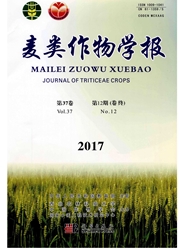

 中文摘要:
中文摘要:
为给盆西平原麦区稻麦两熟制条件下早播早熟型超高产小麦新品种选育提供气候生态依据,深入分析了该区小麦生育期旬平均温度、旬降雨量和旬日照时数。结果表明,该区光、热、水资源在时间上分布具有较好的同步性,从10月中下旬到翌年5月中旬的生态条件基本能够满足弱春性小麦出苗、分蘖、幼穗分化、开花结实和籽粒灌浆的需要,适当提前小麦播期,有利于开发利用10月中下旬的光、热、水资源,并延长了小麦全生育期,有利于小麦高产。综合考虑该区气候生态条件和育种现状,早播早熟型小麦品种的目标播种期、抽穗期和成熟期分别以10月20日、3月中旬和5月10日左右为宜;而产量结构以穗重型为宜,其构成因素为:穗数300×10^4/ha左右,穗粒数达60粒左右,千粒重50 g左右,产量7500 kg/ha以上。
 英文摘要:
英文摘要:
The Chengdu Plain is an important wheat production region in Sichuan province of China. The rotation of Autumn-Sown Wheat (Triticum aestivurn L. ) and rice (Oryza sativa) is the prevailing double -cropping system in the Sichuan Basin. In this cropping system, the rice was harvested from the last ten days of August to the first ten days of September, and the winter wheat was sowed in the first ten days of November. So the land is bare in September and October. To develop new wheat varieties which can be sowed and harvested earlier to adapt to the cropping system and to obtain higher yield, and to provide the theoretical basis for breeding those type of wheat varieties, this paper analyzed the variability of temperature and rainfall and sunlight in the wheat growing period with average temperature and total rainfall and sunlight of every ten days in recent ten years. The results showed that the condition in October is suit for wheat sowing. If the wheat is sowed earlier than present date, it can have longer growth, get more ecological resources and higher yield. According to ecological conditions and the status of wheat breeding in Chengdu Plain, the author suggested that the sowing date of wheat could be put ahead to 20th in October and the safe heading date was 15th in March and that the yield components were spikes per unit area at about 300× 10^4/ha, grains per spike at about 60 and 1000-grains weight at about 50g, and the yield per unit area at above 7 500 kg/ha.
 同期刊论文项目
同期刊论文项目
 同项目期刊论文
同项目期刊论文
 Production of a new wheat cultivar with a different 1B.1R translocation with resistance to powdery m
Production of a new wheat cultivar with a different 1B.1R translocation with resistance to powdery m Variations of tandem repeat, regulatory element, and promoter regions revealed by wheat-rye amphiplo
Variations of tandem repeat, regulatory element, and promoter regions revealed by wheat-rye amphiplo Stripe rust (Puccinia striiformis f. sp. tritici) resistance in wheat genotypes with 1RS chromosomal
Stripe rust (Puccinia striiformis f. sp. tritici) resistance in wheat genotypes with 1RS chromosomal 期刊信息
期刊信息
